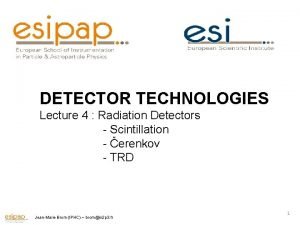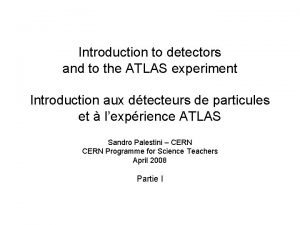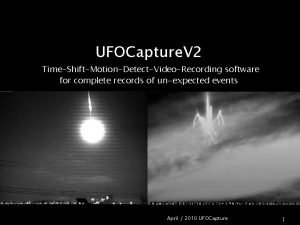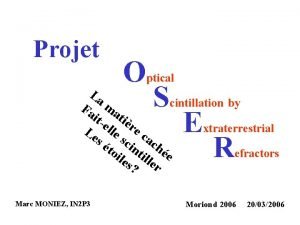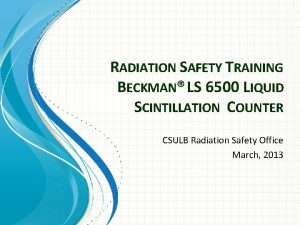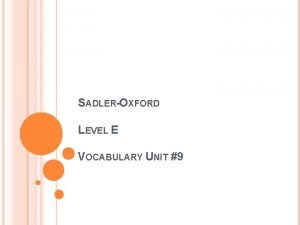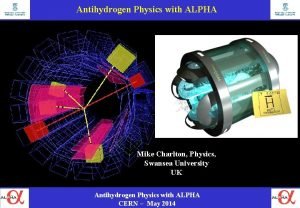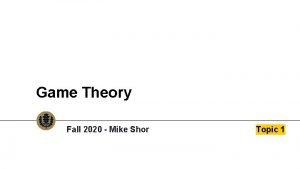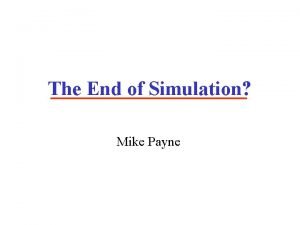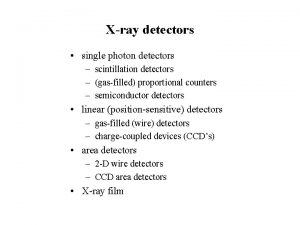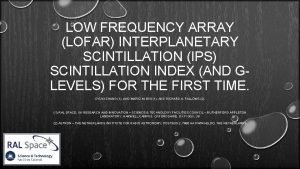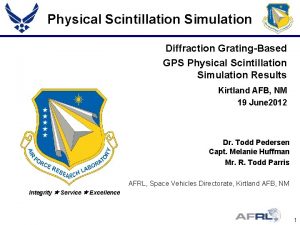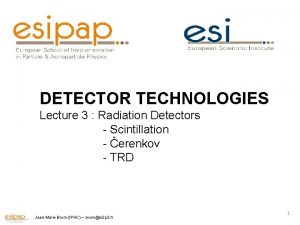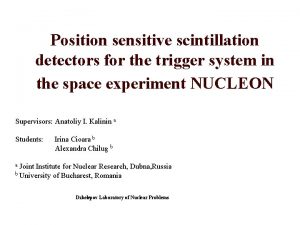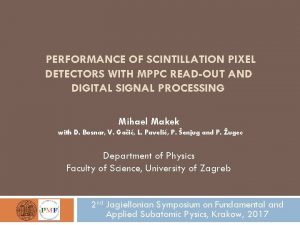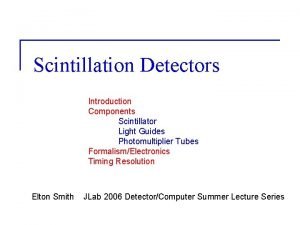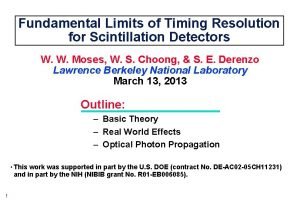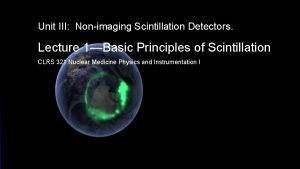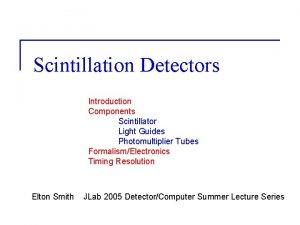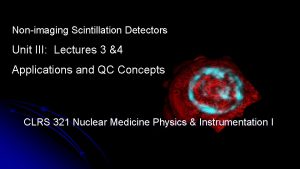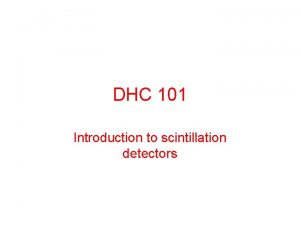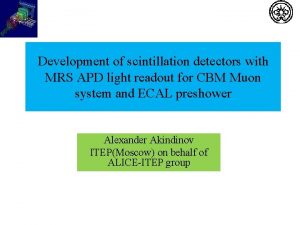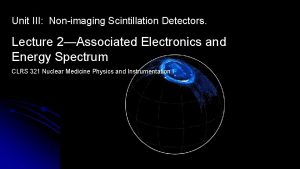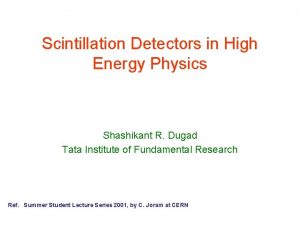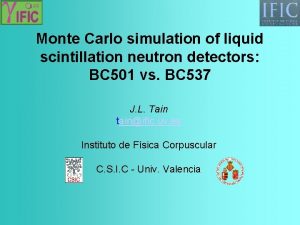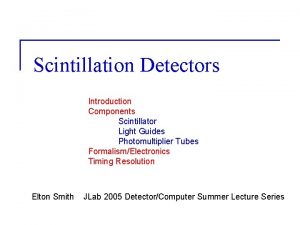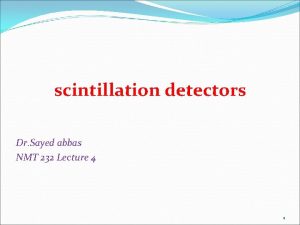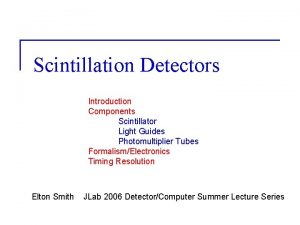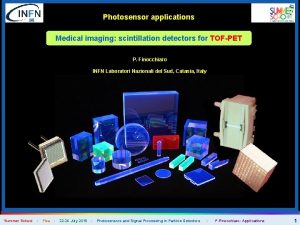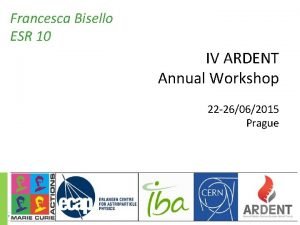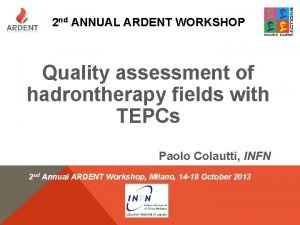Scintillation Detectors Mike Lerch 4 th ARDENT Workshop




























































- Slides: 60

Scintillation Detectors Mike Lerch 4 th ARDENT Workshop, Prague, 2015

Outline

Scintillating History n Early history – 10 th century Japan and China – 17 th century Sir Isaac Newton – Thermoluminescence from diamond – 17 th century Vincentinus Casciarolo (Bologna) coined the term phosphor Phosphor – “gk. Light bearer”– “Bolognian Stone” (Ba. SO 4) – 19 th century -Eilhardt Wiedemann (German Physicist) – coined word luminescence in 1888. n Recent history – – – Glenn Tyrrell – IWORID 2004 Lenard (1862 -1947) – alkaline earth sulfides Pohl (1920 s and 1930 s) Tl activated alkali halides Humboldt Leverenz (1940 s and 1950 s) - Zn. S Ginther (1960 s) – neutron detection glasses Van Loef (2001) – La. Br 3 Yan (2014) – Ba. Cl 2: Eu

Scintillating History Wilhelm Conrad Röntgen Barium Platinocyanide purchased in the late 1800’s by Sidney Rowland, King’s College, London Barium platinocyanide is considered to be the first radiation detector. The scintillation from a screen of platinocyanide alerted Wilhelm Röntgen to the presence of some strange radiation emanating from a gas discharge tube he was using to study cathode rays. Since Röntgen did not know what these “rays” were, he named them x-rays. L. Boatner, AAAS Annual Meeting 2008

Scintillating History This radiographic image was formed by placing the barium platinocyanide on a photographic film. The reason for this effect is that the state of separations chemistry in the 1800’s was poor and the barium platinocyanide was contaminated by radium. Georg Brandes found that sufficiently energetic x-rays produced a uniform blue-grey glow that seemed to originate within the eye itself. Friedrich Giesel (Curie) “saw” radiation from radium “to obtain this effect, one places the box containing the radium in front of the closed eye or against the temple" and "one can attribute this phenomenon to a phosphorescence in the middle of the eye under the action of the invisible rays of radium" (Curie 1900, 1903). In the United States, the Colorado physician George Stover was among the first investigate radiation phosphenes (the proper name for visual sensations induced by radiation within the eye): "Sitting in a perfectly dark room and closing the eyes, if the tube of radium is brought close to the eyelids a sensation of light is distinctly perceived, which disappears on removal of the tube. . . ” L. Boatner, AAAS Annual Meeting 2008

1 st Scintillation Device Sir William Crookes in 1906 http: //www. theodoregray. com/Periodic. Table/Elements/095/index. html#sample 4

Scintillation Detector Kam. LAND‑det. png www. drct. com/Model_700_MCA. htm Amcrys-h. com http: //www. directindustry. com www. physics. isu. edu/radinf/naidetector. htm

Scintillator Types

Scintillation Detector § Scintillation detectors are made up of two primary components; (a) Scintillator and (b) Light detector. § The scintillator converts the kinetic energy of the incident particle or radiation into detectable light. § The light detector converts the light into electrical pulse or signal to register the event, and analyse it.

Scintillation Detector Ideal Scintillator 1. High scintillation efficiency 2. Linear – light yield proportional deposited energy 3. Transparent – own emission light should not be reabsorbed 4. Short decay time – light emission should occur very quickly 5. Mechanically rugged – good practical scintillator 6. Radiation Hard 7. Suitable refractive index – should match the light detector’s refractive index.

Basic Physical Processes Idealy light given off is proportional to energy absorbed. E. g. light yield ~ 1 photon/25 e. V deposited in Na. I, decay time ~250 nsec Photoelectric Effect g absorbed by material, electron ejected Compton Scattering Pair Production ge-→ge- “elastic scattering” g→e+e- creates anti-matter g g g e- e. Na. I hv < 0. 05 Me. V eg 0. 05 < hv < 10 Me. V e+ hv > 10 Me. V g-ray must have E>2 me Attenuation of the gamma rays is energy dependent radiation length of Na. I ~2. 5 cm but only useful for E > few Me. V Richard Kass, 880. P 20 Winter 2006

Cerenkov Light The Cerenkov effect occurs when the velocity of a charged particle traveling through a dielectric medium exceeds the speed of light in the medium. Index of refraction (n) = (speed of light in vacuum)/(speed of light in medium) Will get Cerenkov light when: speed of particle > speed of light in medium For water n=1. 33, will get Cerenkov light if v > 2. 25 x 1010 cm/s Huyghen’s wavefronts Radiation (c/n)t No radiation q bct Angle of Cerenkov Radiation: In a time t wavefront moves (c/n)t but particle moves bct.

Number of photons from Cerenkov Radiation Classical electrodynamics (Frank&Tamm 1937, Nobel Prize 1958) energy loss per wavelength (l) per dx for charge=1, bn>1: a=fine structure constant, n(l) index of refraction. Re-write in terms of the number of photons (N) using: d. N=d. E/E Simplify the above by considering a region were n(l) is a constant=n: Þ Calculate the number of photons/dx by integrating over the wavelengths that can be detected by our photodetector (l 1, l 2): Note: if using a phototube with a photocathode efficiency that varies as a function of l then we have:

Number of photons from Cerenkov Radiation For a typical phototube the range of wavelengths (l 1, l 2) is (350 nm, 500 nm). Richard Kass We can simplify using: For a highly relativistic particle going through a gas the above reduces to: GAS For He we find: 2 -3 photons/meter (not a lot!) For CO 2 we find: ~33 photons/meter For H 2 O we find: ~34000 photons/meter Photons are preferentially emitted at small l’s (blue) For most Cerenkov counters the photon yield is limited (small) due to space limitations, the index of refraction of the medium, and the phototube quantum efficiency.

Organic Scintillators Organic Scintillator § Not necessarily regular crystalline lattice. § The light or “fluorescence” process in organics arises from transitions in the energy level structure of a single molecule § § (independent of its state). Transparent to own fluorescence. The intensity of the fluorescence is given by t = time follow excitation t = fluorescent decay time <t> ~ns for most organic scintillators

Organic Scintillators Types of organic scintillators: 1. Pure organic crystals – Anthracene and Stilbene (20 -30% direction dep) 2. Liquid organic solutions – large volume detectors, radiation hard, (quenching due to presence of O 2) 3. Plastic Scintillator – ie polymerized, easily shaped, fast, (low Z) 4. Thin Film – down to 10 mm, fast (ns), low Z 5. Loaded – increased Z by adding Pb, Sn, B, Li, Gd (lower light output)

Organic Scintillator - Response

Organic Scintillator - Response § § § Small fraction of kinetic energy lost by charged particles in a scintillator is converted into fluorescent energy. Rest is lost non radiatively (lattice vibrations or heat) In some cases the response to electrons is linear above ~130 ke. V Much higher for protons or a’s Response is described by the relation between fluorescent energy emitted per unit path length and energy loss of the charged particle per unit path length n . Knoll, G, “Radiation Detection and Measurement” 4 th Ed. , Wiley Significant energy deposition damage of molecules from high density of track quenching of the scintillator efficiency

Organic Scintillators absorption emission § A number of organic compounds fluoresce when molecules are excited. § The benchmark molecule is anthracene. § Compounds are measured in % anthracene to compare light output R. A. Fuh 1995

Organic Scintillator Excited Rings § p-bonds are most common in aromatic carbon rings. § Excited states radiate photons in the visible and UV spectra. § Fluorescence is the fast component § Phosphorescence is the slow component At left: π-electronic energy levels of an organic molecule. S 0 is the ground state. S 1, S 2, S 3 are excited singlet states. T 1, T 2, T 3 are excited triplet states. S 00, S 01, S 10, S 11 etc. are vibrational sublevels. Knoll, G, “Radiation Detection and Measurement” 4 th Ed. , Wiley

Pi-Bonds § Carbon in molecules has one excited electron. § Ground state 1 s 22 p 2 § Molecular 1 s 22 s 12 p 3 § Hybrid p-orbitals are p-orbitals. § Overlapping p-orbitals form bonds § Appears in double bonds

Scintillation Detector Organic Scintillator § Waveshifter – added impurity to “shift” the scintillation light to longer wavelength. Knoll, G, “Radiation Detection and Measurement” 4 th Ed. , Wiley

Organic Scintillator § § Scintillation efficiency = fraction of all incident particle energy converted into light Quenching – refers to any mechanism (de-excitation process) that does not lead to detectable light www. pha. jhu. edu

Organic Scintillator - Response § § Density of damaged molecules is assumed (Birk’s Formulation) to be B(d. E/dx), B = constant Some fraction, k, of these molecules lead to quenching. In the absence of quenching, assume the light yield is proportional to the energy loss: To account for the probability of quenching

Organic Scintillator - Response § For fast electrons (directly or via g - irradiation) § For a-particles

Timing Related Processes 10 -12 s S 1 10 -15 s S 0 10 -7 s § Fluorescence typically involves three steps. § Excitation to higher energy state. § Loss of energy through change in vibrational state § Emission of fluorescent photon. § The time for 1/e of the atoms to remain excited is the characteristic time t.

Organic Scintillator – Pulse Shape Discrimination § § The decay time depends on the type of particle we can discriminate between different particle events using timing pulse discrimination techniques. Light intensity curves differ for different radiation types:

Plastic Scintillation Detectors

Inorganic Scintillators § Fluorescence is known in many natural crystals. § UV light absorbed § Visible light emitted § Artificial scintillators can be made from many crystals. § Doping impurities added § Improve visible light emission

Inorganic Scintillators

Inorganic Scintillators § § § Scintillator is a single crystal with a regular crystalline lattice. Scintillation mechanism depends on the energy states determined by the crystal lattice of the material. Electrons, excited by the incident particle or radiation have only discrete bands of energy available for them to exist. Valence band: - electrons essentially bound at lattice sites Conduction band: electrons have sufficient energy to be free to migrate throughout the crystal. Forbidden band: no energy state exists for electrons in the pure crystal www. tpub. com

NOVEL TECHNOLOGIES FOR CRYSTAL GROWTH Advantages: Feeding Probe Crystal • . Continuous growth process (large size of crystal) • . Fixed “crystal-melt” interface • . Feeding by raw material and activator • . Simple melt level control Melt Crucible GROWTH PROCESS HALIDES GROWTH TECHNOLOGY MILESTONES Bridgman technique activator concentration Novel technique activator concentration Uniform activator distribution

Inorganic Scintillators § To change the wavelength of the scintillation light (to be detected) impurities (activators) are purposely introduced to create levels within the forbidden band gap. (E = hf = hc/l)

Inorganic Scintillators migrate to trap de-excited without any emission “quenching” migrate to trap (recombination forbidden) re- excited out of trap migrate to activator site charged particle or g/X-ray e - h pairs drift to activator site & ionize it recombine via emission of a scintillation light (50 -500 ns) recombines with hole “phosphorescence” (>1 -5 ms)

Inorganic Scintillators § § § § Example : Thallium – activated (doped) Sodium Iodide Na. I(Tl) W = 20 e. V (~3 Eg) 1 Me. V particle 5 x 104 e-h pairs Experimentally: scintillation efficiency shown to be ~12% 1 Me. V particle → 1. 2 x 105 e. V in total light energy. Scintillation photon energy = 3 e. V 4 x 104 photons are emitted. Shows that energy transfer to activator sites is extremely efficient. Na. I(Tl) – “standard” inorganic scintillator (see table 8. 3). Na. I(Tl) – very hygroscopic and long scintillation light decay time (~230 ns). www. tpub. com

Energy Resolution

Inorganic Scintillators www. tpub. com www. stanford. edu/group/ceramics/scintillators. htm

State of the Art Scintillators Material Light Yield (photons/Me. V) Resolution @ 662 ke. V (%) Na. I(Tl) 38, 000 5. 5 BGO 8, 200 9. 0 La. Br 3(Ce) 70, 000 2. 8 LSO(Ce) 39, 000 7. 9 BC-408 Plastic 10, 600 - GS-20 Li Glass ($2930 for 4, 100 17 1 -inch round, 2 mm thick/ $4, 739 for 6. 2 -inch square, 2 mm thick plate) Overview_0704

§ § Scintillator Light Detectors Device that converts the extremely weak light pulse (scintillation pulse) into a corresponding electrical signal. Two types of detectors: § § 1) Photo multiplier tube (PMT) 2)Semiconductor photodetectors PMT’S § Represents “golden” standard in scintillation detectors. § Extremely high gain 1 photon (photoelectron) → 106 e’s § Very fast → picosecond timing resolution is possible § good linearity § customized wavelength sensitivity § position sensitive designs for spatial information are jp. hamamatsu. com available § requires high voltage (1 – 2 k. V) § very sensitive to magnetic fields § bulky in design → low packing fraction § not very rugged or robust § large area can lead to long dead times § low quantum efficiency

Scintillator Light Detectors - PMTs § Outer (glass) envelope (maintain vacuum conditions) low energy electrons accelerated efficiently by internal electric fields. § Two major components: § Photocathode converts scintillation photons to photoelectrons. § Electron multiplier collects the photoelectrons and amplifies them by ~ 106 for every initial photoelectron created.

Scintillator Light Detectors - PMTs § § Charge amplification is very linear. Output pulse at the anode is proportional to the number of original photoelectrons over a wide amplitude. Much of the timing information of the original scintillation light pulse is retained. A short light pulse → electron pulse (width ~ ns) after a time delay of 20 – 80 ns.

Scintillator Light Detectors - PMTs PMT Photocathode § (1) Scinitillation photon absorption & energy transfer to an electron within photoemissive material (depends on incident photon energy, hf ) § (2) Migration of the electron to the surface (some energy loss via e-e collisions) § (3) Escape of the electron from the surface of the photocathode. Must overcome potential barrier at the material-vacuum interface ie work function

Scintillator Light Detectors - PMTs PMT Quantum Efficiency § Q. E. DC(amps/lumen) = current output per unit light flux on surface § Q. E. = # of photoelectrons emitted = 20 – 30 % typically # of incident photons § long l - limit due to low energy photo electron not having enough energy to escape photocathode surface → Fig. 9. 4 § short l - limit due to absorption in the glass before reaching to photoemissive layer → fused silica or quartz extends to ~ 160 nm.

Scintillator Light Detectors - PMTs

Scintillator Light Detectors - PMTs PMT Electron Multiplication § Based on the phenomena of secondary electron emission. § e’s from the photocathode are accelerated and caused to strike the surface of an electrode, called a dynode re-emission of more than one electron. § dynode surface materials are specially chosen to maximize the secondary electrons § Multiplication factor for a single dynode, d = # 2 ndry electrons emitted primary incident electrons Variation of the secondary emission yield with primary electron energy for standard dynode materials and an NEA material [Ga. P(Cs)]

Scintillator Light Detectors - PMTs PMT Pulse Timing Properties § Time characteristics are dominated by the electron “transit time” since photoemission time in the photocathode is very fast (< 0. 1 ns). § Electron transit time – average time difference in photon arrival at the photocathode and the collection of the electron burst at the anode. § Typically 20 – 80 ns → delay only. § For timing applications the spread in the transit time is most important (see figures 9. 10, 9. 11 & 9. 12) Response of a PM tube to a short pulse of light on the photocathode

Scintillator Light Detectors Semiconductor PD’s § High quantum efficiency (improve energy resolution) § low power operation & consumption (10 – 300 V) § extremely good linearity possible § very compact (high packing fraction) → good spatial info. § robust & rugged § insensitive to magnetic fields § intrinsically very fast § more complicated electronics required § complicated geometries → rapidly increases production cost.

Scintillator Light Detectors – Semiconductor Phototdetectors § § § Generally three types of such photodetectors can be considered as replacements for PMTs in certain applications; Conventional photodiodes, avalanche photodiodes and Si. PMs. Scintillator is mounted optically to the PD by optically transparent glue or grease. http: //jp. hamamatsu. com/products/sensor-ssd/index_en. html

Scintillator Light Detectors – Semiconductor PDs Noise in PDs § § Also can reduce noise by using a semiconductor material with a large bandgap, eg. Hg. I (Mercuric Iodide) cf Si (silicon) Finally we could also reduce the capacitance. Silicon drift detectors or by using sapphire substrates.

Scintillator Light Detectors – Avalanche PDs Avalanche Photodetectors § The small amount of charge produced in a conventional photodiode by a typical scintillation event can be increased through an avalanche process in a semiconductor. § High values of applied voltage are required → charge acceleration between collisions → additional e-h pair creation along the collection path → internal gain → better S/N ratio § Solid-state analogue of the gas proportional counter. § Figure 9. 17 – “Reach-through configuration” of an avalanche photodiode. micro. magnet. fsu. edu

Silicon Photomultipliers

Silicon Photomultipliers

Scintillation Detector Modelling v Schematic picture of the experimental layout modelled

Light Collection Simulations § Monte Carlo Simulations were performed by G. Takacs to: § determine the ideal crystal geometry so as to maximise the light output § optimise detector pixel size to improve the DOI measurements. Interaction point above the corner of four pixels

Photodetector Model Experimentally deduced transmission of light at normal incidence from air through the overlayers that make up the optical entrance window of the photodetector. Overlayed is the calculated transmission data from the growth parameters of the photodetector.

Transmission into the PD from LYSO l = 420 nm

Scintillator photon distribution l = 420 nm

Relative light collection grease

Relative light collection

Absolute Light Collection 13, 300 scintillation photons per 511 ke. V event in LYSO
 Scintillation
Scintillation Scintillation detector technologies
Scintillation detector technologies Scintillation liquide
Scintillation liquide Ufocapture
Ufocapture Scintillation
Scintillation Cintillate
Cintillate Beckman ls6500 liquid scintillation counter
Beckman ls6500 liquid scintillation counter Ardent adjective
Ardent adjective Morfool
Morfool Photo detectors
Photo detectors Gravitational wave detectors hear murmurs from
Gravitational wave detectors hear murmurs from Photo detectors
Photo detectors Feature detectors
Feature detectors Nuclear detectors
Nuclear detectors Where are feature detectors located
Where are feature detectors located Streaming potential
Streaming potential Frontier detectors for frontier physics
Frontier detectors for frontier physics Chromatography mobile phase and stationary phase
Chromatography mobile phase and stationary phase Kinesthesis and vestibular sense
Kinesthesis and vestibular sense Vhv voltage detectors
Vhv voltage detectors Diagnosing error in object detectors
Diagnosing error in object detectors Giant wave detectors murmurs universe
Giant wave detectors murmurs universe Feature vectors
Feature vectors Mike condra
Mike condra Mike dean education
Mike dean education Mike mazzone
Mike mazzone Prudent investment fund
Prudent investment fund Mike mazzalongo statement of faith
Mike mazzalongo statement of faith High bias low variance introduction to machine learning
High bias low variance introduction to machine learning Truth about abs .com
Truth about abs .com Mike bennetts
Mike bennetts Mike mazzalongo
Mike mazzalongo Mike fernie wiki
Mike fernie wiki Dr. mike aamodt
Dr. mike aamodt Mike freel
Mike freel Mike paulus
Mike paulus Mike mazzalongo reformed
Mike mazzalongo reformed Paced decision process
Paced decision process Mike charlton
Mike charlton Mike marcula
Mike marcula Remarkable alternative
Remarkable alternative Game theory
Game theory User stories applied
User stories applied Sharon copestake
Sharon copestake Mike heaney
Mike heaney Margaret secord mcmaster
Margaret secord mcmaster Mike roch
Mike roch Greg veramendi
Greg veramendi Mike harryman
Mike harryman Restrictive clause
Restrictive clause Mike mazzalongo genesis
Mike mazzalongo genesis Mike mazzalongo wife
Mike mazzalongo wife Massage therapist
Massage therapist Kain bible
Kain bible Is mike mazzalongo catholic
Is mike mazzalongo catholic Dax davis
Dax davis Mike spann
Mike spann The elements of success by mike kubic
The elements of success by mike kubic Dr mike lloyd
Dr mike lloyd Mike alber
Mike alber Risi kondor
Risi kondor

